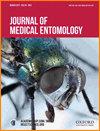Surveillance and detection of Haemaphysalis longicornis (Acari: Ixodidae) in protected areas from Georgia, USA
IF 2
3区 农林科学
Q1 ENTOMOLOGY
引用次数: 0
Abstract
The invasion of the Asian longhorned tick, Haemaphysalis longicornis Neumann, into the United States poses a significant ecological, veterinarian, and public health threat. We conducted a comprehensive tick survey using standard tick flagging protocol for collection over 3 field seasons, March–August, and 56 surveyed sites to identify the presence of H. longicornis in the native ecosystem and prove its establishment according to USDA criteria. Of the total 56 state parks and wildlife management areas (WMA) surveyed, only one was found to be invaded by H. longicornis; detection of H. longicornis occurred at Buck Shoals Wildlife Management area in White County, GA. This site is maintained by the state of Georgia, has no agricultural animals present, and hosts a large white-tailed deer population. After the initial detection of H. longicornis in 2022, an additional field season occurred in 2023, where H. longicornis was confirmed as established based on USDA criteria. The increase in H. longicornis populations from 2021 to 2023 at Buck Shoals WMA points to the rapid spread of this tick within the environment. Our findings provide evidence of the rapid establishment of H. longicornis in the southern edge of suitability for this tick and within the native ecosystem beyond farmlands and private land.在美国佐治亚州的保护区监测和检测长角蝗虫(Acari: Ixodidae)的情况
亚洲长角蜱(Haemaphysalis longicornis Neumann)入侵美国对生态、兽医和公共卫生构成了重大威胁。我们在 3 月至 8 月的 3 个野外季节采用标准蜱标记协议进行了一次全面的蜱虫调查,共调查了 56 个地点,以确定长角蜱在本地生态系统中的存在,并根据美国农业部的标准证明其成立。在调查的总共 56 个州立公园和野生动物管理区 (WMA) 中,只发现一个受到长角蛙入侵;在佐治亚州怀特县的 Buck Shoals 野生动物管理区发现了长角蛙。该地区由佐治亚州政府负责维护,没有农业动物,白尾鹿数量众多。在 2022 年首次检测到长角雉之后,2023 年又进行了一次野外检测,根据美国农业部的标准,长角雉被确认为已确定存在。从 2021 年到 2023 年,H. longicornis 在 Buck Shoals WMA 的数量增加,表明这种蜱虫在环境中迅速传播。我们的研究结果提供了证据,证明 H. longicornis 在适合这种蜱虫的南部边缘以及农田和私人土地以外的原生生态系统中迅速建立。
本文章由计算机程序翻译,如有差异,请以英文原文为准。
求助全文
约1分钟内获得全文
求助全文
来源期刊
CiteScore
4.60
自引率
14.30%
发文量
207
审稿时长
3-8 weeks
期刊介绍:
Journal of Medical Entomology is published bimonthly in January, March, May, July, September, and November. The journal publishes reports on all phases of medical entomology and medical acarology, including the systematics and biology of insects, acarines, and other arthropods of public health and veterinary significance. In addition to full-length research articles, the journal publishes Reviews, interpretive articles in a Forum section, Short Communications, and Letters to the Editor.

 求助内容:
求助内容: 应助结果提醒方式:
应助结果提醒方式:


